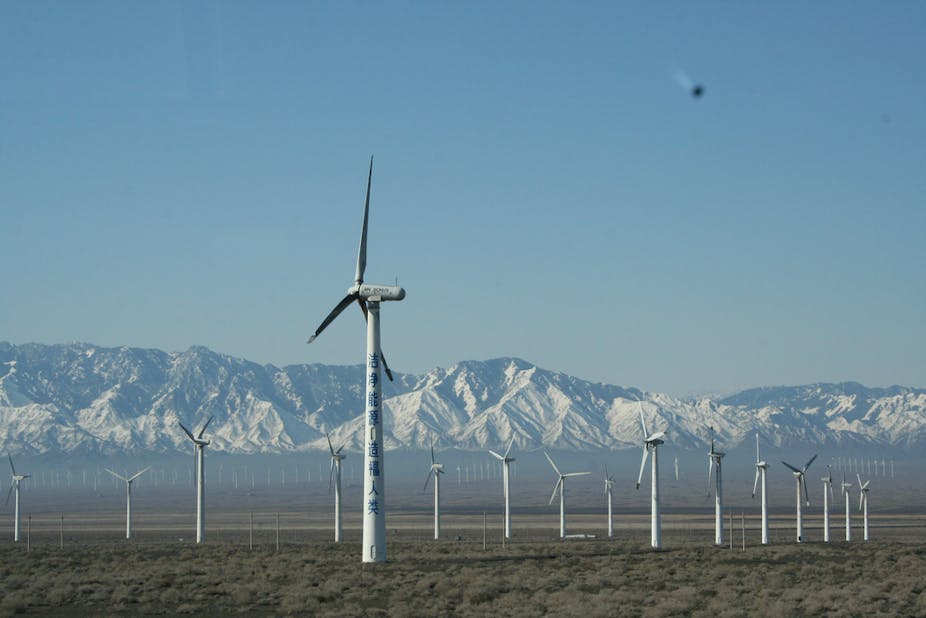Ten years on from the Australia-US Free Trade Agreement, Australia is entering another round of negotiations towards the new and controversial Trans-Pacific Partnership. In this Free Trade Scorecard series, we review Australian trade policy over the years and where we stand today on the brink of a number of significant new trade deals.
The Trans-Pacific Partnership threatens a green trade deal that could ultimately do more to reduce carbon emissions than international climate agreements such as the failed Kyoto Protocol.
Australia is party to an important initiative at Geneva to develop an “Environmental Goods Agreement” designed to be adopted as a multi-country trade agreement by the World Trade Organisation.
This would build on a 2012 Asia-Pacific Economic Cooperation agreement to reduce tariffs on green goods to less than 5% by 2015.
But such a deal is threatened by ongoing negotiations to reach mega-regional trade deals such as the Trans-Pacific Partnership (again involving Australia) where constraints on countries’ capacities to develop their own green strategies are being promoted.
Climate on the trade agenda
There are three global organisations involved in these issues. There is the World Trade Organisation, with absolute governance over the world of production (insofar as it contributes to exports) and trade.
So the trade organisation controls conditions under which green goods (such as the renewable energy systems that are needed to combat climate change) are produced and traded.
On the other hand there are the Intergovernmental Panel on Climate Change (IPCC) and UN Framework Convention on Climate Change (UNFCCC).
The IPCC is empowered to issue peer-reviewed reports on the state of the climate and specifically on the accelerating trend towards irreversible climate change.
The UNFCCC provides the framework for international regulation of carbon, through countries making commitments to reduce national carbon emissions.
Let us call them a combined “World Climate Change Organisation” (WCCO). For at least the past decade and a half, despite repeated warnings, the WCCO has been unable to come up with anything effective to combat global warming.
The ill-fated Kyoto Protocol, adopted in 1997 and coming into force in 2005, expired in 2012 and there has been nothing to replace it. Nations are due to meet in Paris next year to hammer out a successor.
Holding up progress
The World Trade Organisation is currently playing a negative role in the climate change mitigation process. It allows member states to dispute the measures that countries like China and India are taking to build their green goods industries.
These measures include local content requirements attached to inward foreign investment, and subsidies paid indirectly to the nascent solar PV and wind power industries.
These disputes are getting more frequent and the appeals more far-reaching, threatening to stop or slow production of the goods needed to combat global warming in the countries where they are needed most — in China and India.
A green trade agreement?
On a positive note there are 14 countries (including the US, the EU — acting as a single body — China, Japan and Australia) meeting in Geneva to hammer out a separate “Environmental Goods Agreement”. This is modelled on a voluntary agreement reached by the Asia-Pacific Economic Cooperation (APEC) countries and announced at the Vladivostok Summit in 2012.
It calls on APEC countries to reduce their tariffs on a list of “green goods” to below 5% by 2015.
The form of the proposed environmental goods agreement is in turn modelled on the IT trade agreement that was reached at a Singapore conference in 1997. This was adopted by the World Trade Organisation as a “plurilateral agreement” (meaning that it covers several signatory countries but not the entire trade organisation membership) in 1998.
It has since underwritten the huge expansion in trade of IT goods — including chips, computers, PCs, and communications systems.
There is no doubt that an agreement on green goods — if reached through discussions in Geneva and adopted by the World Trade Organisation (say, in 2016) — would boost international trade in green goods, and thereby combat global warming.
But unless it brings in countries’ efforts to build their own green goods industries, it will do only half the job — if that.
Exemptions needed
The way ahead is clear — if politically difficult. The environmental goods agreement needs to have a broader agenda. It should encompass not just “free trade” in a designated set of environmental goods, but temporary exemption from the normal rules of competition for countries looking to build new industries producing those designated green goods.
This exemption need be only for a brief period (say, five years) and apply just to production and trade in the designated goods.
There is evidence that countries can very effectively utilise such an exemption for such a short time — as China did in building its wind power industry value chain by imposing local content requirements on foreign firms wishing to invest in the nascent industry.
Regional trade deal threat
Meanwhile the bilateral trade deals and regional trade deals — and now the “mega” regional trade deals like the Trans Pacific Partnership that is being driven by the US and in which Australia is a major player — continue on their remorseless journey.
They override all attempts to build green industries and threaten countries which impose measures such as local content requirements with court actions known as “investor-state disputes”. These provisions directly threaten a signatory country’s sovereign power to implement legislative measures as it sees fit.
It is only when we look closely at world trade and its governance that the obstacles to reaching a comprehensive climate change agreement become clear.
Because of its membership in all the negotiating organs, Australia has a unique opportunity to influence the outcome — one way or the other.
This article draws on research prepared for the 2014 Workshop “Ten Years since the Australia-US Free Trade Agreement: Where to for Australia’s Trade Policy?”, sponsored by the Academy of the Social Sciences in Australia and Faculty of Arts and Social Sciences, UNSW Australia.

